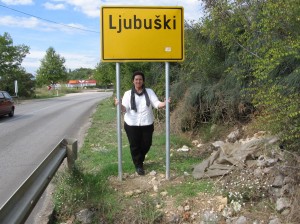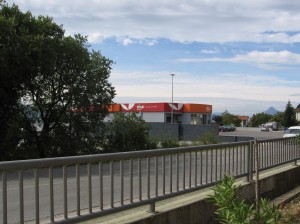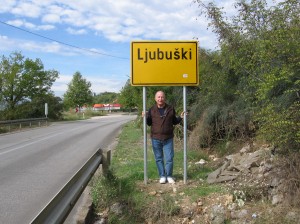Today was a very long time coming. One impetus for this trip is a quest to discover my maternal Croatian roots. In 1907 my mom’s 19-year-old father, Jozo Dzaic, left his home in Klobuk, then-Austria, for the long trip through Ellis Island to America. There, as Joseph Dzaich, he started his restaurant business, married Kata Ribaric from Kajgana, and raised 6 children. Joseph never returned to Klobuk, and no other family member has ever been there….until today. I wanted to see where he came from and discover any evidence of the family he left behind.
I spent some time in the days prior to this day plotting our route to Klobuk. Google Maps is extraordinary in its knowledge of the networks of roads in the most remote areas; its ability to discern the quality of those roads is not completely perfected. The first route Google Maps suggested was to head straight over the mountains from Dubrovnik, and, once over them, venture north. Fortunately, as the 19-year old attendant at the Internet cafe handed me the route print-out, he commented “you know, Bosnian roads are not so good.” He then sat with me and helped plot a route up the coast on the M-6 (he called it the Adriatic road) to Opuzen, turn east on the M-9, cross the Bosnian border at Metkovic, turn north on the M-6 through Ljubuski to Klobuk. We also took time to research how we would leave Klobuk and get to our overnight destination in Mostar. My new friend wished me well, thanked me for the tip I gave, and went back to his pizza. Thank goodness for the kindness of strangers.
Saturday morning Mike and I left Dubrovnik in nice little rented Peugeot and headed up the Adriatic coast. The beauty of the Croatian coast with its hundreds of island is well known, but what we were struck with is the spectacular clear blue skies and waters. It looks to be completely unpolluted, crystal clear and clean. The southern Croatia coast is a narrow strip of land flanked by tall mountains, on the other side of which is known since the 1990s as the country of Bosnia and Herzegovina. The geographic demarcation is clear; those mountains are extremely domineering and certainly nearly impassable in most areas, and the coast is the jackpot of scenery, seafood and access to the outside world. No wonder so many wars have been fought to gain control of this strip of land. Interestingly, Bosnia and Herzegovina’s border does hit the coast for what seems like no more than a 10-mile section, and we needed to provide our passports as we crossed through.
To supplement our Google Maps route printout, our Garmin GPS, fully updated with the latest European maps, succeeded in locating Klobuk. We found the GPS most useful for noting your current location, tracking your car on the map, though we had to turn off the volume as its constant suggestions to “make a u-turn” or to turn off onto a mountain road became frequent and annoying. There is a clear distinction in road maintenance and quality between Croatia and Bosnia & Herzegovina, although the Bosnian highways were safe and navigable. As we reached Lujubuski, a large city in a plain below Klobuk, we noted a large market with the name “Dzajic” emblazoned on the side, and stopped to snap a photo, and continued into the hills toward Klobuk. My grandfather had indicated “Ljubuski” as his birthplace on his American Intent to Gain Citizenship application, I suspect because it was the largest town with any commerce close to Klobuk. We continued on, but noted for future research, Ljubuski might be the best source of documents.
Our route started gaining elevation as we drove into the hills to Klobuk. Growing up, we had been told the Croatian word “klobuk” means “hat,” and Papa’s village got its name from a distinctive hill. It was very exciting, rounding a bend, to discover the klobuk-shaped hill. We stopped and snapped a photo. Passing the Klobuk road sign, we stopped at the first cemetery we saw to look for names. Mike noted that the cemetery seemed new, all the headstones certainly are. We searched but did not find any Dzaic names, though the location was the perfect spot to shoot a video I had been rehearsing. Here are a couple of snapshots from that area. I’m having difficulty uploading the video to YouTube, and may have to wait until my return to the U.S. It was a very emotional moment for me as I realized I had reached my grandfather’s home town.
KLOBUK MOUNTAIN
We proceeded north along the two-lane highway, looking for homes and people. Passing scatterings of homes in various stages of maintenance, we spotted a church in the distance and drove over. The front doors of St. Mark the Evangelist church were open, and we spotted some people cleaning inside. Parked the car and approached; no one spoke English, but one man was brought forward who asked if we spoke German. Unfortunately, communication was an issue; I showed them the pictures I had brought with me of the 6 young men who came to the U.S. from Klobuk, their names written on the back. I pointed to the word “Dzaic” and raised my hands in question – they shook their heads “no.” Next time I’ll bring my Croatian or German-speaking friends. We looked through the church cemetery for some recognizable names; the closest one we found as “Dzekusic.” We did note that several surnames resemble local towns “Culjak” and “Medjugore” so the tradition of naming families by location seems to continue.
Not one to be easily thwarted in my quest, I noted that several newer model cars had taken a one-land road off the main highway along-side the church into the hillside. I encouraged Mike to follow them, hoping to find friendly, English-speaking folk, and we proceeded across a fairly new wooden bridge to a pretty little area with a few homes. Mike’s public investigator radar was activated when he noted that these new-model cars were actually all late-model Mercedes driven by well-dressed middle-aged Middle-Eastern men, who, in his estimation, were probably packing heat. It was his advice that we skedaddle as quickly as possible (“skedaddle” is my translation for the words he actually used). We noted that yet another Mercedes had crossed the wooden bridge towards us and had pulled over – I thought it was to kindly let us by, but Mike noted he was talking on his cell phone and checking us out. We headed back to the highway and stopped to make one last video – this time with a new spin. This experience leads me to believe that the story we had been told about my grandfather’s educated brother being executed in Klobuk in approximately 1944 was true, and Klobuk has developed to be a haven for some not-so-seemly activity disguised by the rough and remote geography of its hills. I’m hopeful that some day we will learn our assessment is incorrect, but for now, we felt it best to get on to the haven of our next stop, Mostar.







Thank you for taking me along. Matto
Maggie, your writing is so interesting and descriptive, along with the photos, it really makes you feel like you are there (wish we were!) Your family stories are wonderful, glad you are living out a dream trip! Be safe, much love!! Julie & Roy
I’m becoming like the teen-agers who’s every other word is OMG. Just don’t get in trouble with your zeal to find Dzaich history. Do enjoy the country, sights, food, and above all people. If you run into things of interest please continue to share. You are so kind to use so much of your time in order to share with us. Mama may have been right when she said Papa’s birthplace was full of mean and angry people. Things might get a lot better as you get up into her area. Since it is near the Capitol there my be more people who speak English. Sounds like this is unlike any trip you have ever taken. Mike, U know how sweet and innocent Manda is please protect her from her need to know if it looks unsafe. Love U, MGM